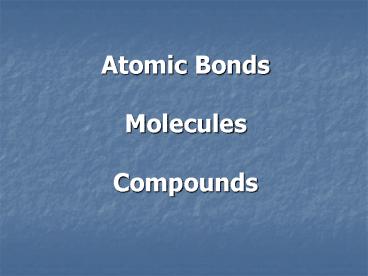Atomic Bonds Molecules Compounds - PowerPoint PPT Presentation
1 / 20
Title:
Atomic Bonds Molecules Compounds
Description:
Certain diatomic elements exist only as diatomic molecules in nature ... Fluorine Diatomic Molecule. Since they share 2 electrons the outer energy level is now full ... – PowerPoint PPT presentation
Number of Views:47
Avg rating:3.0/5.0
Title: Atomic Bonds Molecules Compounds
1
Atomic Bonds MoleculesCompounds
2
CHEMICAL COMPOUNDSWhat I will know this week!
Read
- I will describe . . .
- an ionic bond
- a covalent bond
- and identify molecules
- and write chemical equations
3
(No Transcript)
4
CHEMICAL BOND
Copy
- FORCE OF ATTRACTION THAT HOLDS
- 2 ATOMS TOGETHER
- The type of bond depends on what the atoms do
with their valence electrons
5
Ionic Bonds
Copy
- IONIC force of attraction between 2 oppositely
charged ions - Ionic bonds occur when a metal and a non-metal
ion react, the metal loses electrons and the
non-metal gains electrons - Ions are charged particles that form when an atom
GAINS OR LOSES electrons
6
POSITIVE OR NEGATIVE CHARGE?
Copy
- Atoms that LOSE an electron have a POSITIVE charge
Sodium Atom Sodium Ion (1)
11 e- 10 e- 11 p
11p 12 n 12 n
7
POSITIVE OR NEGATIVE CHARGE?
Copy
- Atoms that GAIN an electron have a NEGATIVE
charge
Chlorine Atom Chloride Ion (-1)
17 e- 18 e- 17 p 17p
19 n 19 n
8
Negative ion names
Copy
- Add the suffix ide to the element name
- Examples
- Chlorine Chloride (part of salt)
- Fluorine fluoride (helps prevent cavities)
9
How to make an ion
- In a stable atom the number of protons the
number of electrons - In an ion the number of protons stays the same
BUT the number of electrons changes
Copy
10
Valence electrons
Copy
- Atoms changed to ions tend to lose all valence
electrons (last energy level) which leaves the
2nd to last energy level filled. - Read
- Metals tend to lose valence electrons net
positive ion cation - Non-metals tend to gain electrons net negative
ion anion
11
Ion Reactions
Copy
- Sodium Chloride Sodium Chloride
- Table salt Na1 Cl-1 NaCl
- (charges cancel)
12
Ion Reactions
Copy
- Metal ions reacting with non-metal ions
- 1. form a neutral compound
- 2. electrons move from one atom to another atom
- 3. an ionic compound results from an ionic bond
13
Periodic Table in general
Copy
- Group 1 1 ion
- Group 2 2 ions
- Group 13 3 ions
- Group 15 -3 ions
- Group 16 -2 ions
- Group 17 -1 ion
- Group 14 can be or
- Transition metals vary 1 2 3
- Group 18 (noble gases) cannot be ions
There are exceptions to these
14
(No Transcript)
15
Covalent Bonds Molecules
Copy
- Covalent bonds occur when two or more non-metal
atoms share electrons and combine to form a
molecule - Molecule a neutral group of atoms held together
by covalent bonds, it is the smallest particle of
a covalent compound
16
Diatomic Molecules
Copy
- Diatomic molecules are made of 2 covalently
bonded atoms - Certain diatomic elements exist only as diatomic
molecules in nature - Examples hydrogen, oxygen, nitrogen, chlorine,
fluorine, bromine and iodine
17
Fluorine Diatomic MoleculeSince they share 2
electrons the outer energy level is now full
Read
18
Complex Molecules
Copy
- Made of 3 or more covalently bonded atoms
- Carbon is very often the basis for the molecules
- Examples water, carbon dioxide, plastic,
gasoline body cell molecules such as
carbohydrates and protein
19
Water Molecule complex molecule
Read
Both the hydrogen And oxygen outer energy
level Is full because the atoms are Sharing
electrons
20
(No Transcript)































